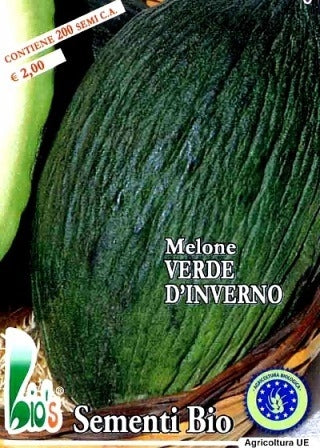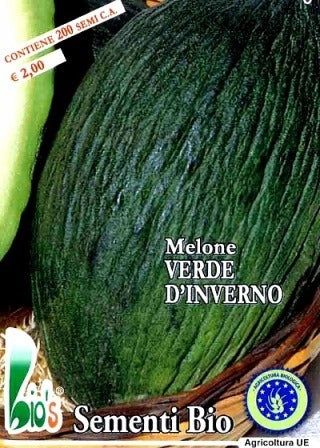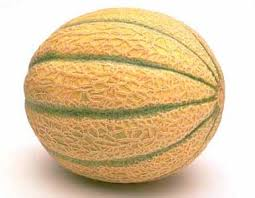Origin and diffusion
Originally from Africa, melon is now widespread throughout the world. In Italy it is grown largely in open fields but also in greenhouses.
Botanical characters
The melon is an annual Cucurbitaceae consisting of a creeping main stem, which branches and can become a climber by placing supports.
The roots are particularly developed on the surface, but also go very deep.
The fruit is a peponid of considerable size and weight (1-4 kg) consisting of an epicarp ("peel") welded to a fleshy mesocarp which constitutes the edible part, inside which a cavity forms filled with a spongy and flaccid mass in which numerous seeds are inserted.
The melon is a demanding plant, it requires high temperatures, fears excessive humidity, and requires deep and perfectly drained soil.
Variety
Based on the characteristics of the fruit, 3 varietal groups of melon are distinguished: cantaloupes, netted and winter melons.
– Cantaloupe melons : the fruits are globular, with smooth or slightly warty skin, green-grey in colour, with well-marked grooves; the pulp has an orange or salmon color and is very fragrant; these melons are early, medium sized (weight from 0.6 to 1.5 kg), and have a short shelf life.
– Netted melons : the fruits are oval or rounded, with densely reticulated skin due to peridermal tuberous formations; the ribs are often missing or not very marked; the pulp is green-yellow or orange in colour, very fragrant; the weight of the fruits varies from 1 to 2.5 kg, the shelf life is poor.
– Winter melons : they have medium to large sized fruits (weight from 1.5 to 4 kg) appreciated for the possibility of being preserved for many months (until winter): the fruits are smooth and without ribs, yellow in color or dark green, with white, light green or yellow pulp, sweet but not very fragrant. These melons are grown mainly in the southern regions where the hot and dry environment favors the sweetness and shelf life of the fruit.
Unfortunately, there are many local melon populations that tend to be supplanted by more uniform F1 hybrids that respond in terms of quality and resistance to certain adversities (Fusarium, downy mildew, etc.).
Cultivation technique
To prevent the attack of cryptogams and soil parasites (fusarium, verticillosis, nematodes)
becomes indomitable, it is best not to grow melons on the same soil before several years have passed.
Sowing is done in late spring (April-May), when the temperature has reached 14-15 °C. The optimal density is obtained with rows 2-2.5 m apart and plants at 0.8-1 m on the row. In greenhouse cultivation, the density is higher (1.5-2 plants per m2) because the plants are not left to crawl on the ground, but are grown vertically using wires or nets in order to better exploit the precious space of the greenhouse.
The cultivation of mulched melon with the use of seedlings to be transplanted has no negligible importance; the objective is to be able to bring forward the planting (by 20-30 days) and the ripening of the fruits (by 10-20 days). These forcing systems are having success in the Centre-North.
Weed control is done with weeding as long as the development of the crop allows it; weeding must be rather superficial to avoid damaging the roots which are particularly developed in the first layers of soil. Even if in certain southern areas winter melon is traditionally grown in dry conditions, irrigation is usually practiced for ready-to-eat melon: by rain, furrows, drip or with perforated hoses placed under the mulch.
An intervention on the plant considered necessary until now is trimming with which the main stem first and then the secondary stems are appropriately trimmed, leaving 2-4 leaves; in this way the emission of female flowers is favored and anticipated; today it is a matter of debate whether this practice is really advantageous for production.
Fertilization and biodynamic treatments
Given the greed for nutrients, it is necessary to use the heap to provide the soil with organic substance, at least two treatments with preparation 500 are also essential.
In the case of not particularly favorable summers, it is possible to contribute to full ripening by distributing preparation 501 with already formed fruits, in this way the ripening processes are promoted, avoiding the creation of rot on the fruits that are not yet ripe.
The use of nettle macerate is recommended, both to counteract the attack of sucking insects and as a nitrogenous foliar fertilizer.
Collection and production
Harvesting begins approximately 90-110 days after sowing and continues for 15-30 days. Melons must be harvested at a very specific stage of development because a delay compromises shelf life, an advance compromises quality (at least 10% sugar content). Visible signs of ripening are the detachment of the peduncle from the fruit (in certain netted varieties), the appearance of concentric cracks around the peduncle, the disappearance of the hair from the peduncle, etc.
For cantaloupes and nets, conservation makes no sense because their destiny is immediate consumption, while winter melons can be stored for up to 5 months at 7-10 °C and with 85-90% relative humidity.
Adversity and parasites
The most fearsome and frequent parasites that can attack melons are:
White mal (Erisiphe cichoracearum). It forms powdery spots on the leaves resulting in yellowing and necrosis. Sulfur horn treatments are preventative.
Peronospora (Pseudoperonospora cubensis). It forms spots on the leaves which are initially translucent (oil stains), then become yellow-brownish, with grey-purple mold on the underside; the foliage thus attacked dries up completely in a few days. Adopt adequately long rotations, drip irrigation avoiding wetting the foliage, carry out preventive treatments with sulfur horn to prevent and control this fearful disease.
Tracheofusarium (Fusarium oxysporum). It causes yellowing and wilting of the entire plant, followed by rubbery growths at the base of the stem and longitudinal splits. Cultivation on infected soil must be avoided for 10 years.
Cucurbit aphid (Aphis gossypii). Aphid with a yellowish to dark green color that colonizes cucurbits on which it causes yellowing and decay of leaves, flowers and fruits; is a dangerous vector of cucumber mosaic virus. Prevent by regularly distributing nettle macerate.
Nutritional characteristics
Melons are similar in composition to watermelons. However, they have a higher content of vitamin C and A.
The presence of these two vitamins gives melon antioxidant properties. The abundance of carotenoids stimulates the production of melanin and promotes tanning by protecting the skin from the sun's rays. Furthermore, this vitamin improves vision and strengthens bones and teeth.
It has refreshing, diuretic, purifying and laxative properties and is therefore indicated in case of constipation and/or hemorrhoids and rheumatic pain.
The addition of salt (for example by combining it with ham) and pepper makes the melon more easily digestible and less laxative.
The abundance of water and the reduced caloric intake make it a valid ally in slimming diets.
The soothing virtues of the pulp make it suitable, in the form of healing pastes, for treating burns and local inflammations.




